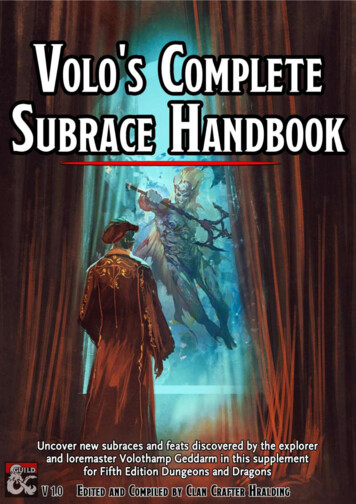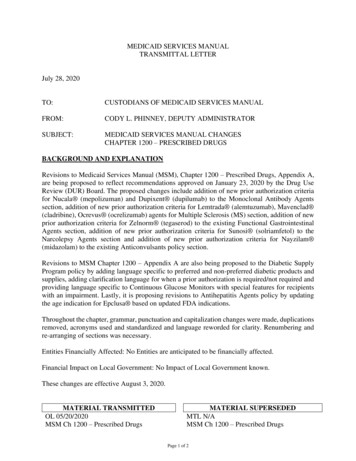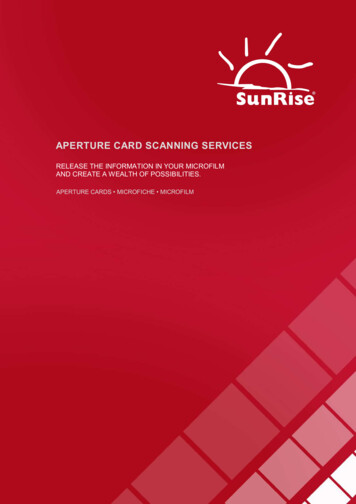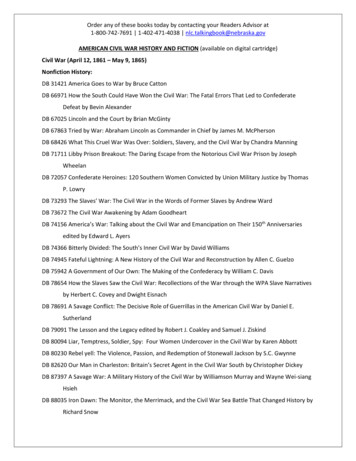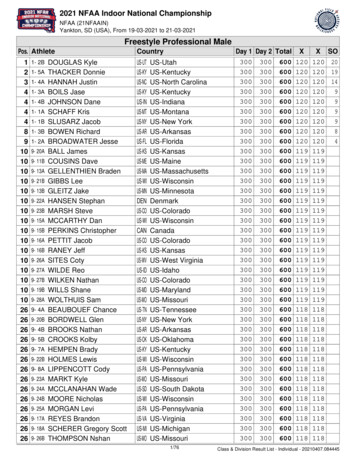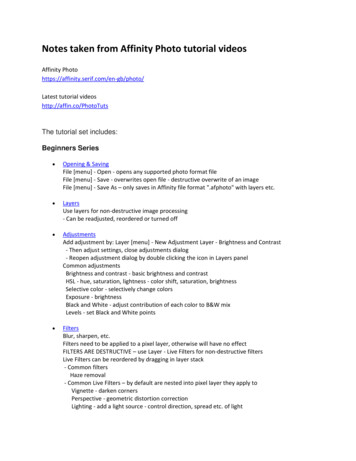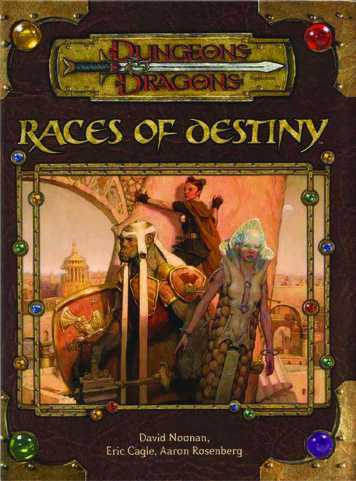
Transcription
CDRESEIDGNERIC CAGLE, DAVID NOONAN,AARON ROSENBERGD E V E L O P M E N TDITCORMICHELE CARTER, GREG COLLINSM A N A G I N GE D I T O RM A NAG E RANDREW J. FINCHVERARADAM REXTISTA R T I S T SD E S I G N E RDEE BARNETTCARTOGRATODD GAMBLEPHERG R A P H IC P RODU C T ION S P E C I A L I S TANGELIKA LOKOTZSENIOR ART DIRECTOR, RPGSTACY LONGSTREETO FD & DDAWN MURING R A P H I CM A N A G E RD I R E C T O RD I R E C T O R ,ED COX, WAYNE ENGLAND, DAVID HUDNUT,CHUCK LUKACS, JEFF MIRACOLA,MONTE MOORE, JIM NELSON,MICHAEL PHILLIPPI, ERIC POLAK,RICHARD SARDINHA, RON SPENCERSCHRISTOPHER PERKINSDEV E L OP M E N TOSI N T E R I O RKIM MOHAND E S I G NA R TTT E A MANDY COLLINS, MICHAEL DONAIS,ANDREW J. FINCHEIR P GR & DBILL SLAVICSEKI M A G ET E C H N I C I A NBOB JORDANP R O D U C T I O NM A N A G E R SJOSH FISCHER, RANDALL CREWSBased on the original DUNGEONS & DRAGONS rules created by Gary Gygax and Dave Arneson and the new DUNGEONS & DRAGONSgame designed by Jonathan Tweet, Monte Cook, Skip Williams, Richard Baker, and Peter Adkison.This WIZARDS OF THE COAST game product contains no Open Game Content. No portion of this work may be reproduced in anyform without written permission. To learn more about the Open Gaming License and the d20 System License, please visit www.wizards.com/d20.U.S., CANADA, ASIA, PACIFIC,& LATIN AMERICAWizards of the Coast, Inc.P.O. Box 707Renton WA 98057-0707Questions? 1-800-324-6496EUROPEAN HEADQUARTERSWizards of the Coast, BelgiumT Hofveld 6d1702 Groot-BijgaardenBelgium 322-467-3360620-17737-001-EN9 8 7 6 5 4 3 2 1First Printing: December 2004DUNGEONS & DRAGONS, D&D, DUNGEON MASTER, d20, d20 System, EBERRON, FORGOTTEN REALMS, WIZARDS OF THE COAST, Player’s Handbook, Dungeon Master’s Guide, MonsterManual, Races of Destiny, all other Wizards of the Coast product names, and their respective logos are trademarks of Wizards of the Coast, Inc., in the U.S.A. and other countries. AllWizards characters, character names, and the distinctive likenesses thereof are property of Wizards of the Coast, Inc. Distributed to the hobby, toy, and comic trade in the United Statesand Canada by regional distributors. Distributed in the United States to the book trade by Holtzbrinck Publishing. Distributed in Canada to the book trade by Fenn Ltd. Distributedworldwide by Wizards of the Coast, Inc., and regional distributors. This material is protected under the copyright laws of the United States of America. Any reproduction or unauthorizeduse of the material or artwork contained herein is prohibited without the express written permission of Wizards of the Coast, Inc. This product is a work of fiction. Any similarity to actualpeople, organizations, places, or events is purely coincidental. Printed in the U.S.A. 2004 Wizards of the Coast, Inc.Visit our website at www.wizards.com/dnd
ContentsIntroduction . . . . . . . . . . . . . . . . . . . . . . . . . . . . . . .4What Is a Race of Destiny?. . . . . . . . . . . . . . . . . .4What’s in This Book . . . . . . . . . . . . . . . . . . . . . . . .4What You Need to Play . . . . . . . . . . . . . . . . . .4Chapter 2: Half-Elves and Half-Orcs. . . . . . .33The Half-Elf: A Day in the Life . . . . . . . . . . . . .34Half-Elf Psychology . . . . . . . . . . . . . . . . . . . . . . .34Age Confusion in Childhood . . . . . . . . . . .34Quiet Exterior, Inner Turmoil . . . . . . . . . .34The Foreigner Mentality . . . . . . . . . . . . . . . .34The Half-Elf Life . . . . . . . . . . . . . . . . . . . . . . . . . .35Leisure . . . . . . . . . . . . . . . . . . . . . . . . . . . . . . . .35Arts and Crafts . . . . . . . . . . . . . . . . . . . . . . . . .36Technology and Magic . . . . . . . . . . . . . . . . .36Half-Elves at War . . . . . . . . . . . . . . . . . . . . . . .38Half-Elf Society and Culture . . . . . . . . . . . . . .39Half-Elves and Other Races . . . . . . . . . . . . . . . .39Half-Elf Religion . . . . . . . . . . . . . . . . . . . . . . . . . .41Half-Elf History and Folklore . . . . . . . . . . . . .41Half-Elf Language . . . . . . . . . . . . . . . . . . . . . . . . .41Half-Elf Settlements . . . . . . . . . . . . . . . . . . . . . .41Creating Half-Elf Characters . . . . . . . . . . . . . .41Chapter 3: Illumians . . . . . . . . . . . . . . . . . . . . . .51A Day in the Life . . . . . . . . . . . . . . . . . . . . . . . . . .51Description . . . . . . . . . . . . . . . . . . . . . . . . . . . . . . .52Overview . . . . . . . . . . . . . . . . . . . . . . . . . . . . . .52Illumian Racial Traits . . . . . . . . . . . . . . . . . .53Psychology . . . . . . . . . . . . . . . . . . . . . . . . . . . . . . .56Illumian Plotters . . . . . . . . . . . . . . . . . . . . . . .56The Illumian Life . . . . . . . . . . . . . . . . . . . . . . . . .56Leisure . . . . . . . . . . . . . . . . . . . . . . . . . . . . . . . .57Arts and Crafts . . . . . . . . . . . . . . . . . . . . . . . . .57Technology and Magic . . . . . . . . . . . . . . . . .58Illumians at War . . . . . . . . . . . . . . . . . . . . . . .59Society and Culture . . . . . . . . . . . . . . . . . . . . . . .59Cabal Structure . . . . . . . . . . . . . . . . . . . . . . . .60Cabal Types . . . . . . . . . . . . . . . . . . . . . . . . . . . .61Laws and Justice . . . . . . . . . . . . . . . . . . . . . . . .72Travelers and Renegades . . . . . . . . . . . . . . . .72Illumian Religion . . . . . . . . . . . . . . . . . . . . . . . . .72Human Gods . . . . . . . . . . . . . . . . . . . . . . . . . . .73Abstract Philosophy . . . . . . . . . . . . . . . . . . . .73The Illumian Pantheon . . . . . . . . . . . . . . . . . . . .73Tarmuid, the First . . . . . . . . . . . . . . . . . . . . . .73Aulasha, the Librarian . . . . . . . . . . . . . . . . . .74Glautru, the Seer . . . . . . . . . . . . . . . . . . . . . . .75Soorinek, the Doubter . . . . . . . . . . . . . . . . . .75Syeret, the Lightbringer . . . . . . . . . . . . . . . .76Wathaku, the Silent . . . . . . . . . . . . . . . . . . . .77History and Folklore . . . . . . . . . . . . . . . . . . . . . .78Ritual of Words Made Flesh . . . . . . . . . . . .78The Journey of Neverlost Kaodei . . . . . . . .78The Ascension of Tarmuid . . . . . . . . . . . . . .78The Sack of the Library . . . . . . . . . . . . . . . . .79Raising Elirhondas . . . . . . . . . . . . . . . . . . . . .80The Search For Trueroot . . . . . . . . . . . . . . . .80The Hunting Secret . . . . . . . . . . . . . . . . . . . .81Language . . . . . . . . . . . . . . . . . . . . . . . . . . . . . . . . .81Illumian Phrasebook . . . . . . . . . . . . . . . . . . .81Illumian Names . . . . . . . . . . . . . . . . . . . . . . . .82Example Cabal: Bloodwing . . . . . . . . . . . . . . . .82Important Cabal Members . . . . . . . . . . . . . .83Elirhondas, Shadow Metropolis . . . . . . . . . . . .87Creating Illumian Characters . . . . . . . . . . . . . .89Special Illumian Options . . . . . . . . . . . . . . .89Illumians as Characters . . . . . . . . . . . . . . . . .89Chapter 4: Other Races of Destiny . . . . . . . . .91Using This Chapter . . . . . . . . . . . . . . . . . . . . . . .91Monster Classes . . . . . . . . . . . . . . . . . . . . . . . .91Aasimar. . . . . . . . . . . . . . . . . . . . . . . . . . . . . . . . . . .92Aasimar Racial Traits . . . . . . . . . . . . . . . . . . .93Doppelganger . . . . . . . . . . . . . . . . . . . . . . . . . . . . .93Doppelganger Racial Traits . . . . . . . . . . . . .95Doppelganger Monster Class . . . . . . . . . . .95Half-Ogre . . . . . . . . . . . . . . . . . . . . . . . . . . . . . . . .96Mongrelfolk . . . . . . . . . . . . . . . . . . . . . . . . . . . . . .97Mongrelfolk Racial Traits . . . . . . . . . . . . . . .99Sea Kin . . . . . . . . . . . . . . . . . . . . . . . . . . . . . . . . . . .99Sea Kin Racial Traits. . . . . . . . . . . . . . . . . . 102Sharakim . . . . . . . . . . . . . . . . . . . . . . . . . . . . . . . 102Sharakim Racial Traits. . . . . . . . . . . . . . . . 104Skulk . . . . . . . . . . . . . . . . . . . . . . . . . . . . . . . . . . . 104Skulk Racial Traits . . . . . . . . . . . . . . . . . . . .105Skulk Monster Class . . . . . . . . . . . . . . . . . 106Racial Traits at 1st Level . . . . . . . . . . . . . . 106Class Skills . . . . . . . . . . . . . . . . . . . . . . . . . . . 106Class Features . . . . . . . . . . . . . . . . . . . . . . . . 106Tiefling . . . . . . . . . . . . . . . . . . . . . . . . . . . . . . . . . 106Tiefling Racial Traits . . . . . . . . . . . . . . . . . 107Underfolk . . . . . . . . . . . . . . . . . . . . . . . . . . . . . . 108Underfolk Racial Traits . . . . . . . . . . . . . . . 109Age, Height, and Weight . . . . . . . . . . . . . . . . .110TABLE OFCONTENTSChapter 1: Humans . . . . . . . . . . . . . . . . . . . . . . . . .5A Day in the Life . . . . . . . . . . . . . . . . . . . . . . . . . . .6Human Psychology . . . . . . . . . . . . . . . . . . . . . . . .6Energy and Ambition. . . . . . . . . . . . . . . . . . . .6Aggression . . . . . . . . . . . . . . . . . . . . . . . . . . . . . .6Focus on the Future . . . . . . . . . . . . . . . . . . . . .7Adaptability and Variety . . . . . . . . . . . . . . . . .7Human Behavior . . . . . . . . . . . . . . . . . . . . . . . .7Human Life . . . . . . . . . . . . . . . . . . . . . . . . . . . . . . . .8Leisure . . . . . . . . . . . . . . . . . . . . . . . . . . . . . . . . .8Arts and Crafts . . . . . . . . . . . . . . . . . . . . . . . . .10Technology and Magic . . . . . . . . . . . . . . . . .11Humans at War . . . . . . . . . . . . . . . . . . . . . . . .13Society and Culture . . . . . . . . . . . . . . . . . . . . . . .14Society’s Drive to Organize . . . . . . . . . . . . .14Social Class . . . . . . . . . . . . . . . . . . . . . . . . . . . .15The Immediate Family . . . . . . . . . . . . . . . . .15Relying Less on Tradition . . . . . . . . . . . . . . .16Humans and Other Races . . . . . . . . . . . . . . . . .16Religion . . . . . . . . . . . . . . . . . . . . . . . . . . . . . . . . . .17How Humans Worship . . . . . . . . . . . . . . . . .17Urbanus . . . . . . . . . . . . . . . . . . . . . . . . . . . . . . .18Zarus . . . . . . . . . . . . . . . . . . . . . . . . . . . . . . . . . .19Other Forms of Faith . . . . . . . . . . . . . . . . . . .20History and Folklore . . . . . . . . . . . . . . . . . . . . . .20Mythic Origins . . . . . . . . . . . . . . . . . . . . . . . .21Legends . . . . . . . . . . . . . . . . . . . . . . . . . . . . . . . .22Language . . . . . . . . . . . . . . . . . . . . . . . . . . . . . . . . .25Gutterspeak . . . . . . . . . . . . . . . . . . . . . . . . . . . .26Gutterspeak Phrasebook . . . . . . . . . . . . . . . .26Cities and Settlements. . . . . . . . . . . . . . . . . . . . .26Human Expansion . . . . . . . . . . . . . . . . . . . . .26Settling the Frontier . . . . . . . . . . . . . . . . . . . .27Building a Community . . . . . . . . . . . . . . . . .27Human Architecture . . . . . . . . . . . . . . . . . . .28Visiting a Human Settlement . . . . . . . . . . .28Human Economies . . . . . . . . . . . . . . . . . . . . .28Example City: Three Falls. . . . . . . . . . . . . . .28Creating Human Characters . . . . . . . . . . . . . . .32Special Human Options . . . . . . . . . . . . . . . .32Humans as Characters . . . . . . . . . . . . . . . . . .32Half-Elves as Characters . . . . . . . . . . . . . . . .41Special Half-Elf Options . . . . . . . . . . . . . . . .42The Half-Orc: A Day in the Life . . . . . . . . . . . .42Half-Orc Psychology . . . . . . . . . . . . . . . . . . . . . .43Quick to Judge, Quick to Anger . . . . . . . . .43Brutal Childhoods. . . . . . . . . . . . . . . . . . . . . .43No True Place in Society . . . . . . . . . . . . . . . .43Heritage of Shame . . . . . . . . . . . . . . . . . . . . . 44Living in the Now . . . . . . . . . . . . . . . . . . . . . 44The Stupid Stereotype . . . . . . . . . . . . . . . . . 44The Half-Orc Life . . . . . . . . . . . . . . . . . . . . . . . . 44Leisure . . . . . . . . . . . . . . . . . . . . . . . . . . . . . . . 44Arts and Crafts . . . . . . . . . . . . . . . . . . . . . . . . .45Technology and Magic . . . . . . . . . . . . . . . . .45Half-Orcs at War . . . . . . . . . . . . . . . . . . . . . . .46Half-Orc Society and Culture. . . . . . . . . . . . . .46The Solace of Friendship. . . . . . . . . . . . . . . .47Half-Orcs and Other Races . . . . . . . . . . . . . . . .47Half-Orc Religion . . . . . . . . . . . . . . . . . . . . . . . . .48Half-Orc History and Folklore . . . . . . . . . . . .48Half-Orc Language . . . . . . . . . . . . . . . . . . . . . . . .48Half-Orc Settlements . . . . . . . . . . . . . . . . . . . . .48Creating Half-Orc Characters . . . . . . . . . . . . .49Half-Orcs as Characters . . . . . . . . . . . . . . . .49Special Half-Orc Options . . . . . . . . . . . . . . .50Chapter 5: Prestige Classes . . . . . . . . . . . . . . 111Chameleon . . . . . . . . . . . . . . . . . . . . . . . . . . . . . .111Loredelver . . . . . . . . . . . . . . . . . . . . . . . . . . . . . . 117Menacing Brute . . . . . . . . . . . . . . . . . . . . . . . . . 123Outcast Champion . . . . . . . . . . . . . . . . . . . . . . 126Scar Enforcer . . . . . . . . . . . . . . . . . . . . . . . . . . . 130Shadow Sentinel . . . . . . . . . . . . . . . . . . . . . . . . 137Urban Soul . . . . . . . . . . . . . . . . . . . . . . . . . . . . . .141Chapter 6: Character Options . . . . . . . . . . . .147Skills . . . . . . . . . . . . . . . . . . . . . . . . . . . . . . . . . . . .147Feats . . . . . . . . . . . . . . . . . . . . . . . . . . . . . . . . . . . . .149Racial Feats . . . . . . . . . . . . . . . . . . . . . . . . . . 150General and Racial Feats. . . . . . . . . . . . . . . . . 150Initiate Feats . . . . . . . . . . . . . . . . . . . . . . . . . . . . 154Tactical Feats. . . . . . . . . . . . . . . . . . . . . . . . . . . . 156Racial Substitution Levels . . . . . . . . . . . . . . . 156Half-Elf Bard . . . . . . . . . . . . . . . . . . . . . . . . . 157Half-Elf Fighter . . . . . . . . . . . . . . . . . . . . . . 157Half-Elf Ranger . . . . . . . . . . . . . . . . . . . . . . 158Half-Orc Barbarian . . . . . . . . . . . . . . . . . . . 158Half-Orc Druid . . . . . . . . . . . . . . . . . . . . . . 159Half-Orc Paladin . . . . . . . . . . . . . . . . . . . . . 160Swift and Immediate Actions . . . . . . . . . . . . .161New Spells . . . . . . . . . . . . . . . . . . . . . . . . . . . . . . .162Spell Descriptions. . . . . . . . . . . . . . . . . . . . . . . .163New Psionic Powers . . . . . . . . . . . . . . . . . . . . . 170Power Descriptions . . . . . . . . . . . . . . . . . . . . . 170Chapter 8: Campaigns of Destiny . . . . . . . . 171Elements of a Town . . . . . . . . . . . . . . . . . . . . . 171Community Attributes . . . . . . . . . . . . . . . . . . .175Cityfolk . . . . . . . . . . . . . . . . . . . . . . . . . . . . . . . . 178Occupations . . . . . . . . . . . . . . . . . . . . . . . . . 178Social Status . . . . . . . . . . . . . . . . . . . . . . . . . 179Roleplaying Cityfolk . . . . . . . . . . . . . . . . . 179Sample NPCs . . . . . . . . . . . . . . . . . . . . . . . . . . . 180Encounters . . . . . . . . . . . . . . . . . . . . . . . . . . 1923
Introduction&Races of Destiny is a rules accessory for the DINTRODUCTIONUNGEONSDRAGONS game. It contains information for both playersand DMs. Players will find new feats, spells, and prestigeclasses for their characters—and a new race that may beinspiration for the next character they create. DMs willfind a wealth of building blocks for adventures that takecharacters to human cities or the remote fortresses ofthe illumians—and along the way they’ll meet half-elfdiplomats, half-orc mercenaries, and other characters bothfascinating and dangerous.WHAT IS ARACE OF DESTINY?In most D&D worlds, human societies dominate much ofthe map, and human culture is standard by which othercultures are described. Despite other races’ unusual powersand long histories, it is humanity and its related races thatseem poised to control the future. This book focuses onthese races of destiny—humans and the races that have atleast some human blood within their veins: the half-elvesand half-orcs. It also explores races that were once fullyhuman, such as the illumians, and creatures that ordinarilylive among humans, such as doppelgangers.Themes of destiny, community, and interbreeding unitethe races of this book. Compared to the elves, dwarves,and other longer-lived races, those of human blood havea relatively short time in the world and strive ardently toforge their legacies and reshape the world to suit their needs.Humans explore, conquer, and settle, constantly pushingthe boundaries of civilization. Their villages become towns,their towns become cities, and their cities become thecosmopolitan ports-of-call for the “movers and shakers” ofthe world.Sometimes, the human drive to expand and evolve yieldsremarkable results. The mingling of human and elf bloodgave rise to the first half-elves. The union of humans andorcs brought the first half-orcs into the world. An ambitiousexperiment involving a sorcerous ritual led to the birth ofthe illumian race and an entire society built around thepower of the magic word.WHAT’S IN THIS BOOKMost players and DMs can play human characters without too much strain, so rather than defining humans ingeneral terms, this book explores the trends that haveshaped human cultures throughout history, coveringsuch themes as city-building, religion, art, and war. Racesof Destiny also provides new insights into how humansregard other races, as well as feats and prestige classes thatsuit the humans’ versatility and fit the book’s themes ofdestiny and community.4Within the D&D milieu, humans interbreed more thanany other race. The human tendency to absorb (some wouldsay conquer) other races in this manner is touched on brieflyas a segue into a discussion of halfbreed races, particularlyhalf-elves and half-orcs. Half-elves and half-orcs wouldseem to have little in common besides a shared humanheritage. However, Races of Destiny explores the social andpsychological ramifications of living a life torn between twovery different worlds, covering everything from the halforc’s outcast attitude to the half-elf’s desire for acceptance.The book also provides new feats, prestige classes, racialsubstitution levels, and other goodies that play off theseraces’ dual heritage.To illustrate how humans can evolve within a magicalworld, we introduce the illumians—secret masters whohave used magic language to transcend humanity. Theirambition and thirst for knowledge rivals that of any human;however, they have sacrificed some of their human versatility for access to arcane secrets that manifest as glowingsigils about their heads. Whereas humans gather in cities,illumians find strength and refuge in the enclaves of theirsecret cabals. Herein you’ll find the information you needto create an illumian character, along with enough detailto ground your new character in illumian culture. Races ofDestiny also provides some additional “toys” for illumiancharacters and NPCs to play with, including racial featsand prestige classes. Likewise, DMs should have no troubleinserting the secretive illumians into an ongoing campaign,using them as patrons, allies, or antagonists in the adventures they create.Races of Destiny also discusses the panoply of strangeraces that either live peacefully among humans or have successfully infiltrated human society, including the twistedmongrelfolk, the noble aasimar, the less than noble tieflings,and the subtle doppelgangers. Whether you’re looking foran oddball race to play or your players’ next archenemy,you’ll find something useful here.In summary, this book explores races whose destiny, forgood or ill, is tied to the fate of the human empires of yourworld. If you enjoy playing human characters because of theirversatility and adaptability, you will find new ways to explorethese human qualities in Races of Destiny. If you’re looking fora humanlike race that trades some of its humanity for supernatural abilities, the mysterious illumians might capture yourinterest. Finally, Races of Destiny explores some of the nuancesof the traditionally angst-ridden halfbreed races, revealingwhere they fit within human society and giving them newoptions that make them even more fun to play.WHAT YOU NEED TO PLAYRaces of Destiny makes use of the information in the threeD&D core rulebooks—Player’s Handbook, Dungeon Master’sGuide, and Monster Manual. In addition, it includes a smallamount of material designed for use with the ExpandedPsionics Handbook.
Illus. by C. Lukacsn a world filled with unusual creatures and bizarre races,humans stand on their own as a ubiquitous part of anyfantasy campaign. Because D&D players are themselveshuman, the fictional humans of the game world describea baseline that’s easy to relate to. Humans don’t have thespecial abilities or powers of other races, so they provide acontrast for the more exotic denizens of the D&D world.But humans aren’t boring. No other race has the samecombination of ambition, aggressiveness, and energy. Thoseattributes have enabled humanity to spread far and wide,and in most campaign worlds, human nations cover mostof the map.Humans are interesting because they’re so active. Whiledwarves are mining the depths of the earth and elves arecontemplating ancient mysteries, humans are buildingempires, settling new lands, and fighting titanic wars withone another.The average human isn’t as hardy as the average dwarfor as nimble as the average halfling. The average elf hasa greater knack for arcane magic, and the average orc iscertainly stronger. But human adaptability and energymakes the concept of an “average” human pretty nebulous.Individually, humans are vastly different from one another.Two humans chosen at random have less in common witheach other than two elves—and if the two humans comefrom different cultures, they might have less in commonwith each other than an elf and a dwarf do.Human societies are just as varied as the humans thatcomprise them. Some human nations are sophisticatedand organized, while others are brutal and barbaric.Just by walking down the road in a human land, youcan find yourself among humans who talk, work, play,and worship completely differently from the humansin the community where you started.This cultural variety is why most campaigns havemultiple human nations, each with its own culture.That’s the way of humans—to divide themselves upinto different societies with different behaviors,customs, and aspirations. Elves, on the other hand,tend to have a single culture in most campaigns, evenif their communities are spread across the campaignmap and they’re not politically affiliated with eachother. Put simply, elves usually act like elves. Butit doesn’t mean much to say that humans act likehumans.Roleplaying Application: If you’re playing ahuman character, realize that you’ve got to thinkmore about your home culture, because humansdon’t have the same stereotypical behavior that otherraces have. If a player says, “I’m a dwarf,” you know5
HUMANSCHAPTER 1that he’ll probably act gruff and taciturn, waxing eloquentabout fine stonework and his well-forged axe. That playerhas some obvious hooks to hang his character’s personalityon.But if you say, “I’m a human,” you haven’t said very muchyet. You won’t have clear character hooks until you decidewhat human culture you hail from and what your place wasin that society. You might be an honor-obsessed swordsmanwho reveres his ancestors, or a streetwise gangster with aquip for every situation. Both characters are equally human.Once you get a little more specific about your humancharacter’s background, interesting character hooks willstart to emerge from the decisions you make.A DAY IN THE LIFEDawn broke upon the eastern shore, spilling light throughSenna’s hovel. She rose quickly and tended to the smoldering fire, humming to herself as she cooked breakfast forthe rest of the family.Senna’s father and eldest brother were already awake,slopping the few hogs that were the bulk of their family’swealth and livelihood. Winter was fast approaching, soSenna’s family was feeding the hogs extra in anticipation oftheir sale and slaughter. By now, Senna knew the formula:Half the hogs would go to Duke Rivus in exchange forland and protection. The family would keep two hogs toprovide meat through the winter, and the rest would besold to Kovar the butcher.Although she was used to discomfort, Senna’s handsached as she pounded out the millet used to make breakfast.With luck, she mused, we’ll get enough money to fix the wagonand take a trip to Alarak, city of music and life. . . .A thousand miles south, the sun woke Venarak as itsrays speared through the dense jungle canopy. Venarakstretched his lithe, mud-covered body toward the sun andbegan to intone his morning prayer. “Sacred sun, I give mythanks to you for bringing your strength into our land.Protect my wife Kaneka and my daughter Vporo from thedangers that lurk in our home. Steady my hand as I huntand fill our larders with much meat.”Venarak brought both his hands to his head in a finalsalutation. He picked up his bow and quiver, and givingboth his wife and daughter a peck on their cheeks, headedout into the dense foliage to find game for his family andtribe. . . .Dozens of leagues away, Nima cursed as the blare oftrumpets woke her from her fitful slumber. She rosequickly, groaning at how sore her body was from sleepingin her armor, covered in the mud and filth of the army’scamp. She reached into her pack and pulled out a hunk ofrock-hard jerky, the only food she’d had for weeks sincethe siege began.6In the faint glow of the morning sun, she could alreadymake out the columns of soldiers forming ranks for thenext assault. She heard the cries of the wounded echoingacross the battlefield and quickly tuned them out, tryingnot to let them get to her. Nima grabbed her polearm and,with a resolute sigh, marched to join her comrades for thenext attack. . . .Far from the battlefield, Senjan awoke and dressed quicklywhen he heard the sounds of camels grunting outside hismaster’s compound. The caravan had arrived early, andthere was much to do.Once his master unlocked his arm-shackle, Senjan joinedthe other slaves in removing boxes and packages fromthe sides of the beasts. Fruits from the south, spices fromthe north, and exotic wooden carvings from the islandsettlements in the western sea—all went into bunkershalf-buried in the desert sand. His meal would have towait until everything was unloaded and the caravan crewtended. Such was the life of a slave. . . .HUMAN PSYCHOLOGYMembers of other races shake their heads in amazementwhen confronted with the wide spectrum of personalitiesthat comprise humanity. Even within the same society,humans push the limits on variety. However, regardless ofcultural influence or invidual personality, some psychological traits define the human mind.ENERGY AND AMBITIONIf humans have a central psychological trait, it’s theremarkable energy and drive they apply to their endeavors.Whether in trade, exploration, warfare, or the arts, humanshave an insatiable appetite for pushing the boundaries.Humans are tenacious when they set their minds to something, although not as stubborn as dwarves or as farsightedin their quests as elves. No goal is too far out of reach fora motivated human, and no ambition is too grand. Thisambitious energy impels humans to settle on the edge ofthe wilderness, to build great cities and monuments, andto crusade against those who threaten them.AGGRESSIONHuman ambition is usually tied to another human trait:aggression. Humans have a primal desire to take whatthey do not possess and to expand their reach as far aspossible.While this aggression often translates to violence—froma barroom brawl to a global war—it can take other forms.Political maneuvering, commercial trade, and acquisitionof knowledge are all tools of human aggression. In her ownway, a scheming merchant guildmaster is just as aggressiveas a cavalry captain. She doesn’t just want to enrich herguild, she wants to impoverish her rivals in the process.
As a result of this aggression, other races are oftenwary when dealing with humans. Nonhuman diplomatseverywhere know the aggressive human mentality and aremindful that humans may push too hard or immediatelymake war to get what they want.FOCUS ON THE FUTUREHumans respond well to new beliefs and schools ofthought, including magic and technology, althoughrepressive human societies may hinder the spread of suchadvances (probably to keep them in the hands of the elite).Humans respond to catastrophe with remarkable flexibilityand can bounce back from severe problems with a speedthat amazes some of the other races.Because they’re confident of their ability to adapt,humans naturally seek out challenges that other races finddaunting. A middle-aged human scribe might purchasefarmland on the frontier and learn to farm, leaving his oldlivelihood and community behind. Then, when banditsthreaten his homestead, the new farmer will take up armshimself and train his children to do the same.One manifestation of this adaptability is humans’ acceptance of people who act and behave differently from them.Because there’s so much variety from human to human,it’s easy for humans to be accepting of nonhuman varietyas well. Humans have to deal with each other all the time,so it’s not too much of a stretch for a human to deal with adwarf, an elf, or some more exotic creature.Another aspect of human adaptability is that a givenhuman behaves differently from day to day, so humansare comfortable with changing their own behaviors andpersonality traits. The happy-go-lucky minstrel you meetin the spring might be morose in the summer after a frienddies, then full of wrath and vengeance in the autumn whenhe finds his friend’s murderer.The variety of human existence naturally pulls humanpersonalities in different directions. For example,
9 8 7 6 5 4 3 2 1 First Printing: December 2004 U.S., CANADA, ASIA, PACIFIC, & LATIN AMERICA Wizards of the Coast, Inc. P.O. Box 707 Renton WA 98057-0707 Questions? 1-800-324-6496 EUROPEAN HEADQUARTERS Wizards of the Coast, Belgium T Hofveld 6d 1702 Groot-Bijgaarden Belgium 322-467-3360
